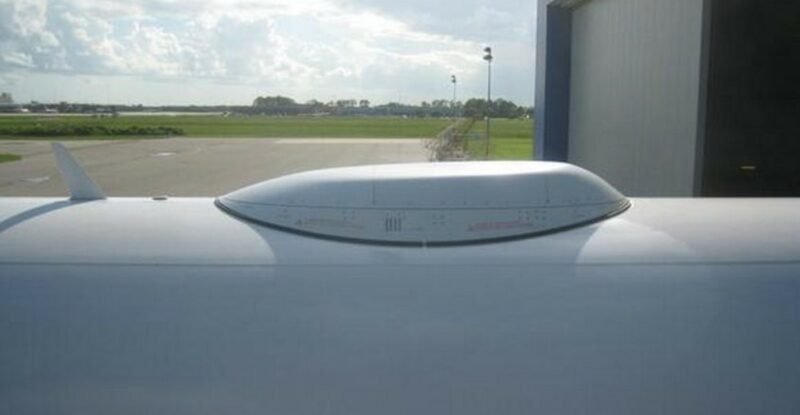Viasat says it has “no firm plans” to support ViaSat-3 aero service for Global Xpress (GX) inflight connectivity installs that use Safran Passenger Innovations’ nextgen GX terminal based on ThinKom Solutions’ Ka2517 VICTS antenna, when interoperability is available for aero across its Ka-band satellite fleet.
If the satellite operator and aero ISP stays the course with this strategy, and the ViaSat-3 program ultimately proves successful, Viasat’s GM-40 gimbaled antenna or indeed a nextgen successor — together with Viasat’s forthcoming Dual-Modem Modman to accommodate interoperability with GX — would effectively be positioned as the more desirable option for those airlines that are keen to tap into GX + ViaSat-3 capacity, perhaps even incentivizing some of them to favor post-delivery retrofit modifications over, say, Airbus’ supplier-furnished linefit HBCplus program for which Viasat is a Ka-band managed service provider with GX service. (After all, Airbus said it has no intention of updating its IFC buyer-furnished equipment catalog.)
Some of Viasat proper’s new customers are already being prepped for full interoperability including forward compatibility with ViaSat-3. For example, Royal Jordanian Airlines is bringing Viasat connectivity to over 40 aircraft. “Service on Royal Jordanian will be enabled for the entire VS-1 (including KaSat over Europe), -2, -3 class network and GX networks as those satellites are made available and will support RJ’s in-flight connectivity mission today and into the future,” Viasat revealed to RGN in February.
Before Viasat completed its acquisition of Inmarsat on 30 May 2023, Ka2517 VICTS was formally approved and certified by Inmarsat for GX network operation. Since then, it has flown many hundreds of hours on the GX network on a number of different Stellar Blu Solutions (formerly GDC) Falcon 300 (Ka2517)-equipped aircraft. But Stellar Blu’s acquirer, Gilat, sees the Falcon 300 as an end-of-life product and is instead focused on electronically steered antenna (ESA) technology, both Stellar Blu’s Sidewinder ESA and its own ESA kit. As such, Falcon 300 customer Saudia is understood to be in line for the Ka2517 antenna, but now supplied by and through Safran Passenger Innovations (SPI).
The SPI terminal with Ka2517 VICTS currently supports some GX retrofit installations at Qatar Airways. Notably, however, it is also available for linefit (with Airbus via its supplier-furnished HBCplus program and a one-time BFE deal; and selectable at Boeing in 2022 with formal catalog entry in the works). And thus far, HBCplus with the Ka-band SPI terminal has proven to be quite popular. Launch customer Emirates, plus Air Algerie, Air India, Ethiopian Airlines, and Philippine Airlines are all set to use Viasat as their managed service provider for GX, with more airline talks underway at Airbus.
With HBCplus, Viasat contracts directly with each airline to provide the managed connectivity services. But each airline will be using the Airbus supplier-furnished terminal (i.e. the terminal integrated by Safran based on Ka2517 VICTS.)
And so, RGN put the question to Viasat: given that Airbus customers are adopting HBCplus (and the fact that Airbus/SPI even agreed a special deal for an airline to deliver the HBCplus VICTS hardware as BFE); as well as the fact that the hardware is going through Boeing linefit, will these VICTS-for-GX installs (whether Airbus linefit or Boeing linefit or indeed retrofitted installs like at Qatar Airways) only ever talk to the GX fleet?
Viasat responded, telling RGN on 19 June:
The SPI Ka2517 VICTS-based terminal is not currently designed to operate on ViaSat-2, ViaSat-3, or certain partner Ka-band satellites. It can operate on the Viasat network using certain GX satellites, including GX-10 when available.
At this time, there are no firm plans to accommodate ViaSat-3 service for VICTS installs
(Operating in Highly Elliptical Orbits, GX10 — both the A & B payloads — are dedicated to the Arctic region, and will integrate seamlessly into the existing and planned GX network.)
Prior to this exchange, Viasat told RGN in February that: “We are working closely with industry partners to develop compatible antennas for the full Viasat constellation of satellites, but to date, the available third-party solutions are only compatible on a subset of Viasat satellites.”
Editor’s note: Given Viasat’s phrasing, it remains to be seen if the company will in time firm up a plan to accommodate operators with the SPI terminal. Thinking out loud, the Airbus SFE program, in particular, is becoming hotly competitive with multiple managed service providers vying for business including those touting multi-orbit solutions; why not use linefit programs to showcase your very best service offering when it’s available, and then offer favorably priced retrofit packages to fit an operator’s remaining fleets with your in-house hardware solution? Would it foster goodwill in the market to hold back interoperability at Airbus? Would Viasat risk ceding potential linefit business to competitors?
Relative to Boeing linefit offerability for Ka2517, which sees ThinKom also going direct under TSA with Boeing, Runway Girl Network asked ThinKom chairman and CTO Bill Milroy if the fitted birds that roll off the line at Boeing will add a modem post-delivery to support (in the near-term) SES/mPOWER, Hughes Network Systems Ka, or indeed Inmarsat-now-Viasat GX?
And will Boeing linefit Ka2517 installs first support GX?
“When the Ka2517 rolls off the line at Boeing, some modems will be installed post-delivery to support the various network options and offerings,” he confirmed. “Unfortunately, we don’t yet know all of the specific details. However, it’s fair to say that the first modems supported will likely be for GX operation, as you surmise.”
Related Articles:
- Korean Air 787 enters commercial service with Viasat GX
- Undisclosed airline inks Airbus, SPI deal to take HBCplus kit as BFE
- Viasat to focus VS3-F1 throughput on aviation, talks interoperable kit
- Viasat sees entire Ka fleet supporting Royal Jordanian in time
- Safran sits pretty as Airbus breaks vertical integration of IFC
- Safran offers VICTS-based GX terminal for Boeing linefit, retrofit
- Viasat grapples with ViaSat-3 Americas reflector deployment problem












